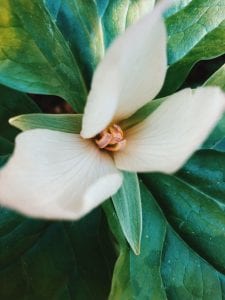San Pedro Valley Park: 37.5779° N, 122.4757° W
On February 21st, our botany class visited San Pedro Valley Park in Pacifica, California. We traveled along the Trout Farm Loop Trail then onto the Brooks Creek Trail, where we had views of the lush, green valley as well as a scenic ocean view with the town of Pacifica in the distance. Overall, the park consists of a variety of habitats, such as grasslands, coastal scrub, and riparian habitats. While we were there, we saw many eucalyptus trees, manzanitas, and yerba santa.
Pretty early into our expedition, we found a Giant white wakerobin (Trillium albidum) of the Melanthiaceae family, which is a perennial herb endemic to western North America. The white wakerobin is a monocot and generally has parts of 3, as is common for monocots. For example, it has 3 white petals surrounded by 3 green sepals, as well as 3 large sessile leaves which are whorled. The leaves exhibit parallel venation and are bright green in color with some mottling (although less pronounced in this individual). The leaves are also ovate in shape with obtuse tips. This plant can grow to be anywhere from 20-70 centimeters in size!
We also found a deathcamas (Toxicoscordion fremontii) which is a perennial herb native to California that belongs to the Melanthiaceae family. The deathcamas is a monocot that is commonly found on grassy or rocky slopes. The flowers are arranged in a raceme inflorescence with each flower attached by a pedicel. The flowers themselves are bisexual and consist of 6 white tepals (sepals and petals), 6 stamens, and a central gynoecium with a superior ovary. The leaves of the deathcamus are basal, long, and linear-lanceolate in shape. As its name suggests, the plant is toxic and contains alkaloids in both its fresh parts (petals, leaves) and dried parts (seeds, capsules).
Near the end of our hike, we encountered Houndstongue (Cynoglossum grande) of the Boraginaceae family. The houndstongue is a perennial herb that is native to California and is confined to Western North America. The flower consists of 5 violet petals, 5 darker sepals, and white appendages in the center. The flowers are arranged in panicle inflorescences, with each flower attached by a pedicle. The leaves for which the plant is named are primarily basal and ovate-elliptic in shape with chordate bases and acute tips. The leaves also appear whorled.
As we walked along the trial, we passed through a eucalyptus forest for a while, which gradually led into a manzanita “forest”, and then gradually into a smaller golden chinquapin “forest.” While we were in the eucalyptus forest, we saw a eucalyptus tree that had fallen down and essentially created a bridge which was super tempting to cross. During the hike, we got to revisit one of my favorite trees, the beautiful madrone, and I came to love the golden chinquapins which we saw for the first time. We came to know about Dirty Santa and Hound’s Tongue and saw grass with blades probably taller than me. Throughout the trip, I had been bracing myself to come face to face with a snake thanks to Professor Paul’s prior warning but luckily we were able to finish the trip without any snake confrontations!
Honorable Mention Species














